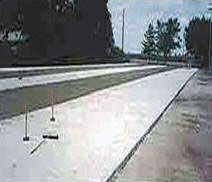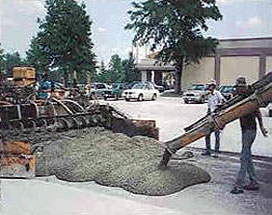Concrete Overlays
Success Story
Overlays | Installation Process | Design Factors | Success Story | Ultra-Thin Overlays
Decatur, IL Holiday Inn
 The Holiday Inn Conference Resort in Decatur, IL needed a new parking lot. Located on the edge of town on Route 36, the hotel was built in the 1960s. The existing parking lot had a curb and gutter around the perimeter, a crushed stone base and an asphalt surface. The lot had been expanded to 36,000 sq. ft and resurfaced with 1.5 inches of asphalt in the 70s, but was beginning to deteriorate again.
The Holiday Inn Conference Resort in Decatur, IL needed a new parking lot. Located on the edge of town on Route 36, the hotel was built in the 1960s. The existing parking lot had a curb and gutter around the perimeter, a crushed stone base and an asphalt surface. The lot had been expanded to 36,000 sq. ft and resurfaced with 1.5 inches of asphalt in the 70s, but was beginning to deteriorate again.
Getting Started
Early in the month of August, the manager of the Holiday Inn contacted Calhoun County Contracting Corporation of Springfield, IL. Harry Rimbey, president, recommended whitetopping. "We'd done a couple of whitetopping projects," says Rimbey, "but this was by far our largest one." According to Rimbey, one of the biggest advantages of overlays are its simplicity. Surface preparation is minimal. Standard concrete-placing equipment can be used. Surface preparation for the Holiday Inn project was unique because a previously-hired contractor had already removed some of the asphalt. Before beginning his project, Rimbey had engineers from Springfield perform a total station survey of the parking lot, showing different parking lot elevations and creating a contour map of the base. Because the hotel sits in the middle of the parking lot, Rimbey also needed to decide how the project was to proceed. He needed to space the job in such a way that the crew could work in one area and customers could park in another.
The Construction Process
 After evaluating the existing surface, the asphalt was roto-milled down, allowing 4 inches of concrete to be placed adjacent to the curb and gutter. The crew then laid a grade so they would not need to remove any more of the base than needed. For the Holiday Inn parking lot, Rimbey recommended a 4-inch-thick overlay. A regular state-highway paving mix from Traver Ready Mixed Concrete (Decatur, IL) was used. The concrete was slipform-paved in 12-ft widths over the existing surface. In some areas the distance was too short to use slipform pavers, so the crew set forms and used vibrating screeds to place the concrete. Rimbey applied a light broom finish to create a nonskid surface.
After evaluating the existing surface, the asphalt was roto-milled down, allowing 4 inches of concrete to be placed adjacent to the curb and gutter. The crew then laid a grade so they would not need to remove any more of the base than needed. For the Holiday Inn parking lot, Rimbey recommended a 4-inch-thick overlay. A regular state-highway paving mix from Traver Ready Mixed Concrete (Decatur, IL) was used. The concrete was slipform-paved in 12-ft widths over the existing surface. In some areas the distance was too short to use slipform pavers, so the crew set forms and used vibrating screeds to place the concrete. Rimbey applied a light broom finish to create a nonskid surface.
After placing the concrete, the crew sawed the controlled contraction joints in a 6-ft square pattern. Transverse and longitudinal joints must be sawed as soon as possible to relieve initial stresses. The crew sealed the joints to prevent moisture and debris from filtering into the overlay system. The parking lot section was then opened to traffic.
Calhoun County Contracting Corporation also replaced the brick pavement entrance, as well as some sidewalks that were deteriorating around the perimeter of the parking lot. Flat areas that weren't draining well were also repaired during the project using underdrain pipes beneath the overlay. The entire project was completed by October 1994.
The Best Choice for Parking Area Rejuvenation
Although concrete has a higher initial cost than asphalt, it lasts much longer and requires less maintenance. "In parking lots, cars drip fluids that deteriorate asphalt," says Rimbey. "And every time you need to seal an asphalt lot, you have to rope off the area, seal, and re-stripe. That inconveniences the customer."
The investment for embarking on overlay projects is minimal if concrete paving equipment is already owned. Equipment ranging from simple hand screeds and floats to slipform paving machines can place, compact, and finish concrete pavement. Rimbey and his crew use a slipform paver, various vibrating screeds, concrete saws, joint-sealing equipment, and various finishing tools.
Guide specifications and additional information on concrete overlays are available through the
American Concrete Pavement Association (ACPA).


